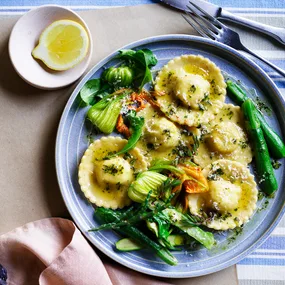Juicy slices of pork wrapped up in leaves with an array of beguiling condiments both salty and spicy make up a Korean classic that’s one of the great party dishes, writes Tony Tan.
Koreans get misty-eyed whenever bo ssäm is mentioned and I can understand why. One of the least demanding Korean specialties to make, bo ssäm is a wonderful composite dish that first made a big impact in the Western world when David Chang offered it at Momofuku Ssäm Bar. If you have bo ssäm in a Korean restaurant, however, the original version is far from that presented by chef Chang. In these restaurants, the pork is almost always simmered, whereas Chang roasts the pork.
So what is bo ssäm? According to walking encyclopedia and importer of Korean food Paul Lee of Melbourne-based Table 181, bo is an abbreviation of bojagi, the traditional gift-wrapping cloth and ssäm means “to wrap”. Bo ssäm uses leaves – of butter lettuce, say, or cabbage – to wrap slices of meat with a selection of dipping sauces and side dishes such as kimchi. It can also include raw garlic and fresh chilli; more often than not, oysters are served, too, and this is sometimes called gul bo ssäm. In Korea, it’s served during the all-important autumn kimchi-making season called kimjang when wombok, or Chinese cabbage, is plentiful.
To make traditional bo ssäm, you need some planning and a soupçon of patience. For optimum dining pleasure, there are six elements: brining the cabbage for wrapping; making the two side dishes, bo ssäm kimchi and an instant Chinese cabbage kimchi called gut juri; cooking the pork and making the two dipping sauces, one with ssämjang, a mixture of doenjang (Korean soy bean paste) and gochujang (Korean chilli paste), and the other with saeujeot, fermented shrimp.
If you are time-poor, you can serve one side dish and drop the salted shrimp sauce. At a pinch, you could buy ssämjang and kimchi, though it’s not quite the same.
Soaking the pork belly removes the blood and porky scent. It’s then simmered with flavouring ingredients such as onion, garlic, ginger, chilli and doenjang (a form of Korean miso), though some cooks may add ginseng, jujubes (Korean dates), nashi and soju. While it’s bubbling away, you make the instant kimchi and dipping sauces. Once the pork is done, slice it into bite-sized pieces and serve it with your choice of condiments.
The classic way to eat bo ssäm is to place a leaf of shiso (aka perilla) over a brined cabbage or lettuce leaf and top with a slice of pork. Dab the pork with ssämjang or saeujeot and top it with kimchi, an oyster and wrap the whole thing up into a parcel, then eat it with your fingers. It’s deliciously messy fun.
For the roasted version, rub the pork with a quarter of a cup each of salt and sugar, then refrigerate it overnight. Drain off the juices and bake the pork in a 140C oven, basting regularly, for four hours until it is fork tender, then remove it, sprinkle it with brown sugar and salt and roast it at 220C for another 10-15 minutes until the sugar is caramelised. Rest it for at least 10 minutes before slicing it and serving with side dishes and wine or beer.
Ingredients
Method
Main
Note The Chinese cabbage kimchi recipe comes courtesy of Paul Lee of importer Table 181. All the Korean ingredients can be sourced from Korean grocers and online from Melbourne-based Korean food specialist Table 181.
Notes










